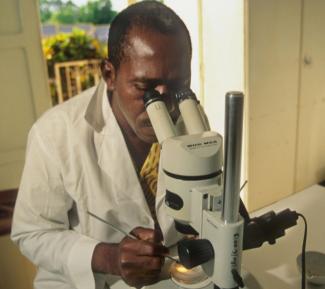Medical research
Diseases of the poor

Some 8 million people are estimated to be infected with Chagas, and most of them live in Latin America. About 25 % of Latin Americans are at risk of suffering from this NTD in their lifetime.
Chagas is caused by a parasite which is transmitted by a blood-sucking bug. The acute symptoms of a fresh infection are fever and sore eyes. A period of dormancy of about 10 to 20 years follows. When the disease finally breaks out, it affects the heart and other organs.
Once the disease has reached this stage, no therapy is effective anymore. Those patients who do not die remain unable to work for the rest of their lives. Therapies would be available earlier, but the problem is that most infected people do not know that they have contracted Chagas. There are towns like Tarija in Bolivia, where 40 % of the people are infected.
Most Chagas-infected people live in Brazil and Argentina, but not everybody there is equally likely to contract Chagas. “It is a disease of the poor,” says Adelina Riarte of the National Institute for Parasitology in Buenos Aires. “A well-fed person who lives in a proper house with plastered walls and roofs, where the bugs can’t breed, is unlikely to get the disease. The insect thrives in huts with thatched roofs and mud walls.”
The WHO perspective
What Chagas has in common with other neglected tropical diseases is that the patients lack purchasing power. Accordingly, pharmaceutical companies do not take interest in developing vaccines and cures. They focus on the health problems that afflict more prosperous societies where affordability is not an issue because most people are covered by private or government-run health insurances.
The World Health Organization (WHO) defines NTDs as “a diverse group of communicable diseases that prevail in tropical and subtropical conditions in 149 countries and affect more than one billion people, costing developing economies billions of dollars every year”. According to the international organisation, they mainly affect people living “in poverty, without adequate sanitation and in close contact with infectious vectors and domestic animals and livestock”. Animal health, veterinary medicine and safe water matter very much in terms of fighting NTDs.
As the WHO points out, NTDs diminish the quality of life and productivity of the affected persons, even if the patients don’t die. Moreover, the symptoms of these diseases are often unclear, which makes a self-diagnosis of the affected persons difficult, so they are unlikely to seek professional help. Typically, these diseases are transmitted or caused by worms or insects, so it would be helpful to improve hygienic conditions. The WHO has prioritised the fight against 17 NTDs (also note review essay by Lea Diehl).
The quest for new pharmaceuticals
“Neglected diseases continue to cause significant morbidity and mortality in the developing world,” argues the Drugs for Neglected Diseases Initiative (DNDi), a civil-society organisation based in Switzerland. NTDs account for 11 % of the global disease burden, according to the DNDi, but only four percent of the 850 new therapeutic products approved between 2000 and 2011 were indicated for neglected diseases.
The DNDi is a non-profit organisation that does research and development (R&D) according to patients’ needs, emphasising collaboration. It aims to develop new medicines for NTDs. It has seven regional offices in Asia, Africa and Latin America. Germany’s Federal Government is among the donors.
In 2012, the WHO published the London Declaration on Neglected Tropical Diseases. In this context, several parties made important commitments. They included pharmaceutical multinationals like Pfizer and Novartis, charitable institutions like the Bill & Melinda Gates Foundation, international organisations like the World Bank and civil-society initiatives like the DNDi. By 2020, they promised:
- to eradicate (reduce to zero the prevalence in the host population) Guinea worm disease,
- to eliminate (reduce global prevalence to minimal amount) lymphatic filariasis, leprosy, sleeping sickness and blinding trachoma (also notice article on fight against lesprosy in Uganda), and
- to control schistosomiasis, soil-transmitted helminthes, Chagas, visceral leishmaniasis and river blindness (onchocerciasis).
In order to achieve these goals, the parties pledged:
- to promote R&D for next-generation drugs,
- to provide tropical countries with adequate funding for implementing NTD programmes and
- to enhance collaboration and coordination on NTDs at national and international levels.
Internationally, there are success stories. In October 2015, Mexico became the third country, along with Colombia and Ecuador, to be declared free of river blindness by the WHO. This success is proof that international collaboration is working. However, 120 million people worldwide are still at risk of contracting this disease.
The WHO currently expects to eradicate Guineas worm disease and blinding trachoma by 2020. Regarding some diseases, for instance rabies, some countries are ahead of the WHO ambitions. In 2013, Bangladesh had managed to reduce the incidence of human rabies being deathly by 50 %, for example, through a combination of mass dog vaccination and increased availability of vaccines free of charge. In May 2016, the World Health Assembly recognised that there are “still many tropical, poverty-related diseases or conditions that remain neglected and for which advocacy, awareness and research are required to develop better diagnostic methods, treatments and control strategies.” One such NTD, which is not on the WHO’s priority list, is melioidosis (see box), zika and ebola.
Sheila Mysorekar is a member of D+C/E+Z’s editorial team.
euz.editor@fs-medien.de
Links
Drugs for Neglected Diseases Initiative:
http://www.dndi.org/
German Network against Neglected Diseases – Deutsches Netzwerk gegen vernachlässigte Tropenkrankheiten:
http://www.dntds.de/en/
World Health Organization (WHO): Neglected Tropical Diseases.
http://www.who.int/neglected_diseases/diseases/en/
WHO: London Declaration on Neglected Tropical Diseases.
http://www.who.int/neglected_diseases/London_Declaration_NTDs.pdf?ua=1
Uniting to Combat Neglected Tropical Diseases (4th Report):
http://unitingtocombatntds.org/report/fourth-report-reaching-unreached








